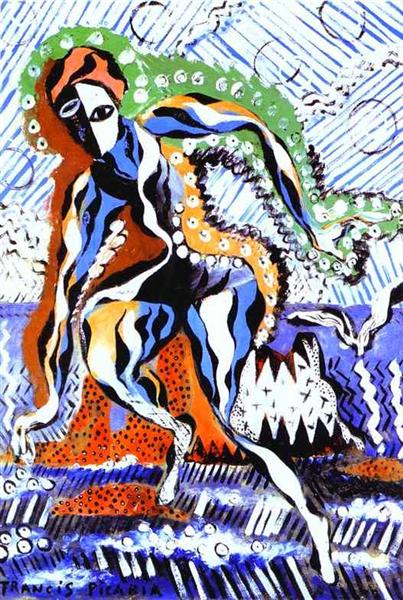Description
Francis Picabia's work "Dawn" (1924) is a vibrant testimony of the artist's mastery in the use of color and shape, as well as its ability to evoke emotions through an aesthetic that challenges the conventions of its time. At a time when art was experiencing a radical transformation towards the abstract and the conceptual, Picabia stood out when fuses figurative and abstract elements, giving his work a singularity that invites reflection.
The paint presents a transition landscape, where the light of dawn seems to overflow on a background that could be interpreted as the ocean or a vast water extension. This use of water as a compositional element is significant, as it reflects the influence of water symbolism as a means of transformation and renewal. The warm tones of orange and yellow, which dominate the upper part of the work, contrast with the darkest depths at the bottom, creating a chromatic harmony that suggests movement and change. This color use is not merely decorative; It acts as an almost emotional approach to the representation of light and time, capturing the ephemeral moment of dawn.
In the center of the composition, figures can be observed that, although they occur schematically and almost abstractly, suggest a human interaction with the natural environment. This aspect marks the transition from the art of Picabia to an approach that preserves the figure but subject to the expression of a broader idea. While the figures are not clearly defined, their presence brings a narrative dimension to the work, suggesting a relationship between man and nature, a recurring theme in the work of many artists of his time.
The work, created in 1924, is registered within the evolution of the modernist movement and reflects the experience of Picabia with Dadaism and Surrealism, although more adventurized towards the abstraction than many of its contemporaries. Picabia was known for his eclectic approach, experiencing with various forms of artistic expression throughout his career. This path, which incorporates influences of photography and mechanics, is also reflected in the composition of "dawn", where the search for new forms of perception through color and light is fundamental.
When observing "dawn", the viewer immerses himself in an almost dreamlike atmosphere, marked by a tension between the real and the abstract. This duality is characteristic of Picabia's work, who blurred the lines between the tangible and the illusory. The work can be considered as a visual dialogue not only about the beauty of the natural world, but also on the internal process of the spectator and its own experience in the contemplation of art.
In conclusion, "dawn" is an impressive intervention in the history of art that combines a deep sense of aesthetics with philosophical explorations about human light and experience. Through its vibrant palette and its evocative composition, Francis Picabia achieves a delicate balance between representation and abstraction, offering the viewer a glimpse of both the beauty of the day that dawns and the complex nuances of artistic perception. This work is, without a doubt, a celebration of the art transformative potential, an invitation to look beyond the immediate and find in each dawn a new possibility.
KUADROS ©, a famous paint on your wall.
Hand-made oil painting reproductions, with the quality of professional artists and the distinctive seal of KUADROS ©.
Art reproduction service with satisfaction guarantee. If you are not completely satisfied with the replica of your painting, we refund your money 100%.

